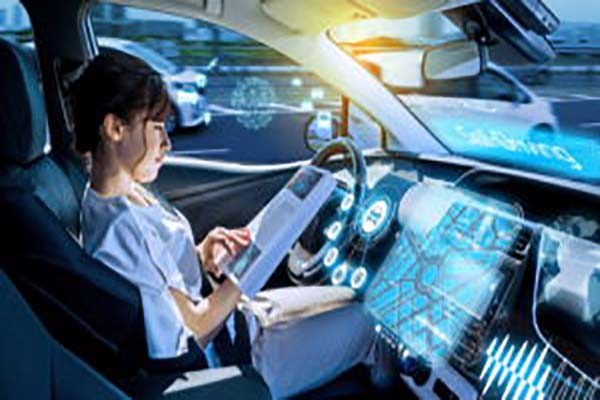Autonomous cars, sometimes referred to as self-driving cars, are automobiles that can sense their surroundings and navigate without the need for human supervision. Sensors, cameras, radar, and artificial intelligence are all used by them to analyze what’s around them and make driving decisions. Since they increase accessibility for those who are unable to drive themselves and improve safety and traffic congestion, autonomous vehicles have the potential to completely transform the transportation industry. But there have been few hassles around the growth of autonomous vehicles. This includes navigating complex and unpredictable environments, ensuring safety and reliability, addressing legal and regulatory issues, dealing with ethical dilemmas, and gaining public acceptance and trust. Additionally, there are technical challenges related to sensor accuracy, communication systems, cybersecurity, and the ability to handle edge cases and unexpected situations on the road. Overall, the development and deployment of autonomous vehicles require a multidisciplinary approach and collaboration among various stakeholders to address these challenges effectively.
Peculiar Comments By Enablers
According to many developers and admirers, traditional cars won’t be as safe as autonomous vehicles. Traffic jams, driving incompetence, and car accidents are all related to human error and emotion. Theoretically, mishaps and accidents caused by people operating vehicles become impossible when human mistake and emotion are removed from the equation. A computer system can process information about the surroundings and other vehicles at a rate that is faster than the human mind can keep up with, regardless of the driving conditions.
IoT a Key Ingredient for Autonomous Vehicles
IoT links self-driving cars to infrastructure, other cars, and the internet. As a result, accidents can be avoided through the use of real-time data collection and processing to make prompt judgments based on the state of the traffic. Additionally, automobiles can monitor their surroundings and identify impending obstacles thanks to IoT-enabled sensors. LiDAR, one of the most recent sensor technologies, scans the environment with lasers. LiDAR sensors that rotate continuously pulse numerous lasers to provide three-dimensional images. When compared to human drivers, autonomous vehicles can react more quickly because to the extremely precise data it delivers. The Internet of Things (IoT) is a vast network that links together various objects and individuals, all of which gather and exchange data regarding their usage and the surrounding environment. While the definition of “things” has undergone significant changes in the past decade, the primary objective of enabling devices to comprehend this information without human involvement remains largely unaltered. Machine-to-machine (M2M) interaction facilitates the connection between isolated sensor systems and servers with minimal or no human intervention. IoT builds upon M2M connectivity, integrating it with web applications and linking it to cloud computing systems. In IoT, physical objects and information technology converge through the combination of hardware and software, fostering innovation in ideas and existing models.
Specific Trends in Autonomous Vehicles
Safety: By removing human error, seeing risks sooner, and reacting more precisely than human drivers, autonomous cars have the potential to greatly increase road safety.
Efficiency: By lowering traffic jams, enhancing traffic flow, cooperating with one another, modifying speeds, and planning the best routes, self-driving cars can maximize transportation efficiency
Accessibility: By offering new mobility options to persons who are unable to drive, such as the elderly, people with impairments, and people without a driver’s license, autonomous cars can completely transform the accessibility of transportation1
Transportation as a Service: It is anticipated that forms of transportation as a service will grow, and shared autonomous vehicles may eventually replace traditional form of vehicles.
The Perils of Autonomous Vehicles
There are hazards and issues associated with autonomous vehicles. Hackers now have more access to things and systems when they are connected to the Internet and other technologies. It would be unsafe and inappropriate for a hacker to take control of a driverless car’s operation if they were able to access the computer system of the vehicle. Before driverless cars become a reality, significant progress must be made in the Internet of Things and self-driving car technologies to stop any potential attacks on the car’s computer systems.
The complexity of the AV infrastructure makes it vulnerable to security and privacy attacks that can endanger the lives of passengers and commuters. Surpassing traditional centralized security systems, blockchain has emerged as the best solution to provide the much-needed security shield to AVs with its data transparency, immutability, and decentralized approach. Therefore, enriching and enmeshing the aforementioned technologies into a robust system will lead to the realization of our much-yearned AV dream into reality.
Conflict between Dependability and Response Time
Response time pertains to the duration it takes for a data packet to travel through various intermediary devices, get to its destination, and be decoded. In addition to focusing on the accuracy of inference, we must also consider another crucial factor, which is inference latency. It is evident that the quality of data and shallow neural networks can greatly impact the accuracy of inference in a pre-trained deep learning model. In order for the data collected by the sensors on the autonomous vehicle to be trustworthy and suitable for making decisions based on them, there needs to be some data preprocessing to enhance its quality, thus enabling the vehicle to make accurate and ethical decisions promptly. Nonetheless, an extra communication delay is introduced to accommodate the time required for data transfer from mobile devices to a more robust edge server. At times, this process may be affected by the dynamics of the channel.
Stern Legal Frameworks
As self-driving cars become more prevalent, legal frameworks must adapt to ensure safety and security for all travelers. Regulations across the globe aim to establish a standard of safety that autonomous vehicles must meet. Ongoing research in the United States and Europe is dedicated to addressing these challenges. Legal issues surrounding autonomous vehicles are complex, involving various public policies, traffic laws, technical standards, and tort law. The term “autonomous” has sometimes led to confusion in legal contexts, as it carries philosophical implications beyond its technical definition of operating without human intervention. Many countries still require a human driver to be present in autonomous vehicles, ready to take control if necessary. While semi-autonomous vehicles have legal guidelines to follow, fully autonomous vehicles must demonstrate their safety compared to traditional vehicles.
Artificial Intelligence and Autonomous Vehicles
Self-driving cars, or autonomous vehicles, utilize artificial intelligence and advanced technologies to navigate roads without human intervention. The potential benefits of self-driving cars include a decrease in accidents caused by human error, leading to fewer fatalities and injuries. Additionally, these vehicles have the capability to enhance traffic flow by communicating with each other and making real-time decisions to optimize routes and speeds, ultimately reducing congestion on roads and highways.
The automotive industry has been completely transformed by artificial intelligence in ways that were previously inconceivable. Self-driving cars and intelligent traffic systems are just a few examples of how AI has changed the way we commute and engage with our vehicles. Through the utilization of machine learning algorithms, vehicles are now capable of autonomously making decisions, adjusting to varying road conditions and traffic flow instantaneously. This advancement has not only enhanced the safety of driving, but has also significantly improved its efficiency and convenience.
Predictive analytics: AI-driven vehicles utilize predictive analytics to forecast the actions of pedestrians and other vehicles on the road. By doing so, the vehicle can proactively address any potential issues and make necessary adjustments to prevent accidents.
Language understanding: Certain autonomous vehicles are integrated with speech recognition capabilities, enabling passengers to interact with the vehicle using everyday language. This feature leverages AI to interpret and act upon verbal instructions.
Deep Learning and Self Driving Cars
Deep learning plays a crucial role in enhancing the precision and dependability of the artificial intelligence systems utilized in self-driving cars. Through the utilization of deep learning algorithms, these systems can be trained on vast amounts of images and videos to facilitate object recognition and classification within the car’s surroundings, including pedestrians, other vehicles, and traffic signs. Moreover, deep learning is instrumental in refining the accuracy of predictive modeling in self-driving cars, enabling the vehicle to analyze sensor data and forecast events such as a pedestrian crossing the road or another vehicle changing lanes unexpectedly.
Autonomous Vehicles in India
The future of self-driving cars holds great promise, and the potential benefits of these vehicles make it an exciting field of development. With advancements in technology, the prospects for autonomous vehicles appear optimistic. The evolution of driverless cars in India is expected to bring forth new challenges and opportunities, and it will be fascinating to witness its progression. As technology continues to improve and issues regarding regulations and infrastructure are resolved, it is likely that Indian roads will see an increasing number of self-driving cars in the years to come.
Nitin Gadkari, the Union Minister of Road Transport and Highways, has stated that the introduction of driverless cars in India will be prohibited in order to safeguard the employment opportunities of drivers. As per a Business Today report, Gadkari emphasized, “I am firmly against the idea of allowing driverless cars in India as it would result in the displacement of numerous drivers from their jobs, a scenario I am determined to prevent.”
Insufficient infrastructure: One of the primary obstacles for the future of autonomous vehicles in India lies in the inadequate infrastructure and regulations. This encompasses poorly marked roads and the absence of reliable digital maps, which are essential for the smooth operation of self-driving cars. Without these necessary improvements, the safe functioning of self-driving cars on Indian roads will be challenging. Unless these issues are promptly addressed, the future of self-driving cars in India will be bleak.
Absence of a comprehensive regulatory framework: The success of self-driving cars in the future hinges on the effectiveness of the regulatory framework established by decision-makers. In order to ensure the safety of passengers and other drivers on the road, it is crucial to have well-defined rules and guidelines for testing and utilizing self-driving cars. Without a clear set of regulations, it will be difficult for companies in India to develop and sell autonomous vehicles.
















